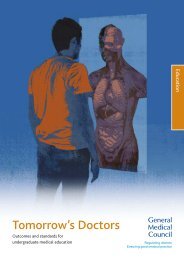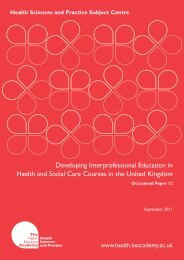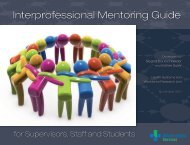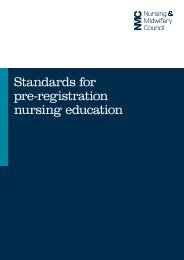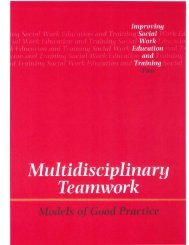(WHO) Patient Safety Curriculum Guide - CAIPE
(WHO) Patient Safety Curriculum Guide - CAIPE
(WHO) Patient Safety Curriculum Guide - CAIPE
Create successful ePaper yourself
Turn your PDF publications into a flip-book with our unique Google optimized e-Paper software.
interventions worked. Health-care leaders, such as<br />
Tom Nolan, Brent James, Don Berwick and others,<br />
have applied quality-improvement principles<br />
to develop quality-improvement methods for<br />
health clinicians and managers. The identification<br />
and examination of each step in the process<br />
of health-care delivery is the bedrock of<br />
this methodology. When students examine each<br />
step in the process of care, they begin to see how<br />
the pieces of care are connected and measurable.<br />
Measurement is critical for safety improvement.<br />
This topic introduces the student to the principles<br />
of improvement theory and the tools, activities<br />
and techniques that can be incorporated into<br />
their practice.<br />
Topic 8: Engaging with patients and carers<br />
Students are introduced to the concept that<br />
the health-care team includes the patient and/or<br />
their carer, and that patients and carers play a key<br />
role in ensuring safe health care by: (i) helping<br />
with the diagnosis; (ii) deciding about appropriate<br />
treatments; (iii) choosing an experienced and<br />
safe provider; (iv) ensuring that treatments are<br />
appropriately administered; and (v) identifying<br />
adverse events and taking appropriate action<br />
[21, 22]. The health-care system underutilizes<br />
the expertise patients can bring, such as their<br />
knowledge about their symptoms, pain,<br />
preferences and attitudes to risk. They are<br />
a second pair of eyes if something unexpected<br />
happens. They can alert a nurse, doctor,<br />
pharmacist or other health-care worker if the<br />
medication they are about to receive is not<br />
what they usually take, which acts as a warning<br />
to the team that checks should be made.<br />
Research has shown that there are fewer errors<br />
and better treatment outcomes when there is<br />
good communication between patients and their<br />
health-care providers, and when patients are fully<br />
informed and educated about their medications<br />
[23–30]. Poor communication between health-care<br />
professionals, patients and their carers has also<br />
emerged as a common reason for patients taking<br />
legal action against health-care providers [31, 32].<br />
Topic 9: Infection prevention and control<br />
Because of the worldwide problem of infection<br />
prevention and control and the efforts by <strong>WHO</strong><br />
to reduce health care-associated infections, it was<br />
considered important that this area be included<br />
in the <strong>Curriculum</strong> <strong>Guide</strong>, not only for consistency,<br />
but also because together with surgical care<br />
and medication, it constitutes a significant<br />
percentage of adverse events suffered by patients.<br />
The problem of infection control in health-care<br />
settings is now well established, with health<br />
care-associated infections being a major cause<br />
of death and disability worldwide. There are<br />
numerous guidelines available to help doctors,<br />
nurses, dentists and others minimize the risks<br />
of cross-infection. <strong>Patient</strong>s who have surgery or<br />
an invasive procedure are known to be particularly<br />
prone to infections and account for about 40%<br />
of all health care-associated infections. This topic<br />
sets out the main causes and types of infections,<br />
to enable health-care students to identify<br />
the activities that put patients at risk of infection<br />
and to prepare students to take the appropriate<br />
action to prevent transmission.<br />
Topic 10: <strong>Patient</strong> safety and invasive<br />
procedures<br />
By recognizing the unacceptable harm caused<br />
by surgery, <strong>WHO</strong> has successfully campaigned<br />
to reduce surgical adverse events. One of the main<br />
causes of errors involving wrong patients, sites<br />
and procedures is the failure of health-care<br />
providers to communicate effectively (inadequate<br />
processes and checks) in preoperative procedures.<br />
Some examples of wrong site/procedure/patient<br />
are: (i) the wrong patient in the operating room<br />
(OR); (ii) surgery performed on the wrong side<br />
or site; (iii) wrong procedure performed; (iv) failure<br />
to communicate changes in the patient’s<br />
condition; (v) disagreements about stopping<br />
procedures; and (vi) failure to report errors.<br />
Minimizing errors caused by misidentification<br />
involves developing best practice guidelines<br />
for ensuring that the correct patient receives<br />
the right treatment [7, 33]. Students can learn<br />
to understand the value of all patients being<br />
treated in accordance with the correct<br />
site/procedure/patient policies and protocols.<br />
Such learning would include the benefits of using<br />
checklists or protocols, as well as knowledge of<br />
the underlying principles supporting a uniform<br />
approach to treating and caring for patients.<br />
One study of hand surgeons found that 21%<br />
of surgeons surveyed (n=1050) reported<br />
performing wrong site surgery at least once<br />
during their careers [34].<br />
Topic 11: Improving medication safety<br />
An adverse drug reaction has been defined<br />
by <strong>WHO</strong> [35] as any response to a medication<br />
that is noxious, unintended and occurs at doses<br />
used for prophylaxis, diagnosis or therapy.<br />
<strong>Patient</strong>s are vulnerable to mistakes being made<br />
in any one of the many steps involved in ordering,<br />
dispensing and administering medication.<br />
Medication errors have been highlighted in studies<br />
31 Part A 2. How were the <strong>Curriculum</strong> <strong>Guide</strong> topics selected?




